-
收藏模板
- 模板信息
- 更新时间:2023-09-22
- 字数:约21656字
- 页数:约11页
- 格式:.doc
- 推荐版本:Office2016及以上版本
- 售价:5 金币
您可能喜欢的文档
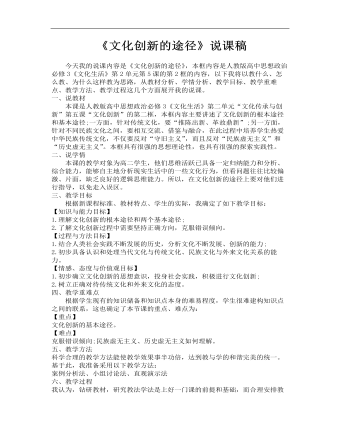
高中思想政治人教版必修三《文化创新的途径》说课稿
二、说学情本课的教学对象为高二学生,他们思维活跃已具备一定归纳能力和分析、综合能力,能够自主地分析现实生活中的一些文化行为,但看问题往往比较偏激、片面,缺乏良好的逻辑思维能力。所以,在文化创新的途径上要对他们进行指导,以免走入误区。三、教学目标根据新课程标准、教材特点、学生的实际,我确定了如下教学目标:【知识与能力目标】1.理解文化创新的根本途径和两个基本途径;2.了解文化创新过程中需要坚持正确方向,克服错误倾向。
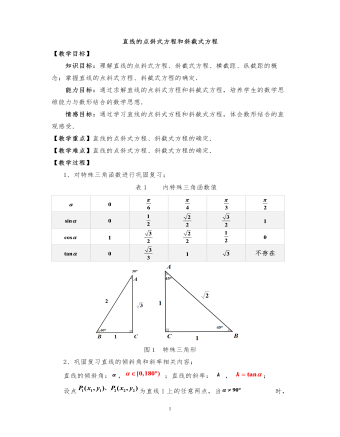
高中数学人教版必修二直线的点斜式方程教案
【教学目标】知识目标:理解直线的点斜式方程、斜截式方程、横截距、纵截距的概念;掌握直线的点斜式方程、斜截式方程的确定.能力目标:通过求解直线的点斜式方程和斜截式方程,培养学生的数学思维能力与数形结合的数学思想.情感目标:通过学习直线的点斜式方程和斜截式方程,体会数形结合的直观感受.【教学重点】直线的点斜式方程、斜截式方程的确定.【教学难点】直线的点斜式方程、斜截式方程的确定.
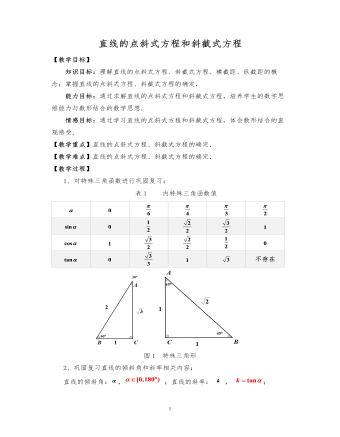
高中数学人教版必修二直线的点斜式方程教案
【教学重点】直线的点斜式方程、斜截式方程的确定.【教学难点】直线的点斜式方程、斜截式方程的确定.【教学过程】1、对特殊三角函数进行巩固复习;表1 内特殊三角函数值 不存在图1 特殊三角形2、巩固复习直线的倾斜角和斜率相关内容;直线的倾斜角:,;直线的斜率: , ;设点为直线l上的任意两点,当时,
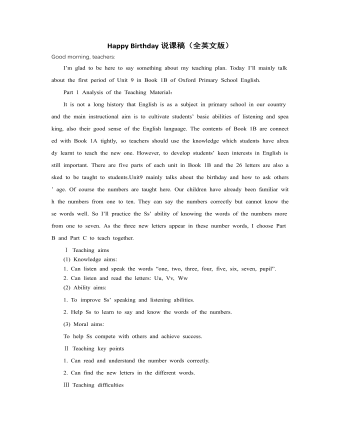
人教版新课标PEP小学英语三年级上册Happy Birthday(全英文版)说课稿
1. Do some exercise on the paper. There are four kinds of exercise here. The exercise 1 is to develop Ss’ ability of listening. Exercise 2 is to practice Ss’ ability of knowing the words. Exercise 3 is to develop Ss’ ability of speaking numbers and letters. Exercise 4 is to make Ss know the words and letters well. These exercises can consolidate the new knowledge from different styles of problems.2. Then tell Ss that we can sing the numbers like “ Do, re, mi, fa, so, la, ti, do” and let them listen to a song named “Do, Re, Mi”. Add some extra knowledge so that Ss will be glad to see that the numbers can be used in another way.Step 4 Homework1.Read the numbers from 1 to 7 and 7 to 1 five times.2.Read the letters “u, v, w” five times follow the tape.Reading is a useful way for the Ss of Grade One to practice the knowledge. Ask Ss to imitate reading from the tape in order to make Ss have a good habit of listening and let them have a better pronunciation.Step 5 Board writingI ‘ll put the seven numbers like a scale(音阶)as I’ll let Ss know that we can sing out the numbers. When it comes to listen to the song, I ‘ll draw a musical note on Bb. Unit 9 Happy birthday!sevensixfivefourthree U u V v W wtwo pupil five windowoneThat’s all for my class designing. Thank you for listening!
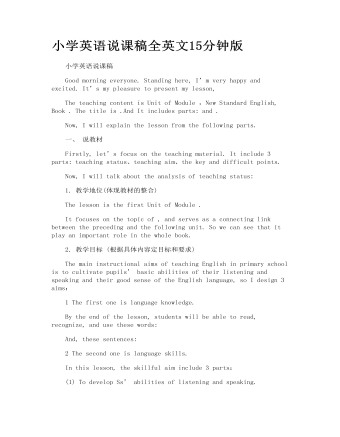
小学英语说课稿全英文15分钟版
一、 说教材 Firstly, let’s focus on theteaching material. It include 3 parts: teaching status、teachingaim、the key and difficult points. Now, I will talk about the analysis of teaching status: 1. 教学地位(体现教材的整合) The lesson is the first Unit of Module . It focuses on the topic of , and serves as a connectinglink between the preceding and the following unit. So we can see that it playan important role in the whole book. 2. 教学目标 (根据具体内容定目标和要求) The main instructional aims of teaching English inprimary school is to cultivate pupils’ basic abilitiesof their listening and speaking and their good sense of the English language,so I design 3 aims:
- 查看更多相关Word文档
Body Language说课稿4篇
必修四uni4说课稿一
Unit 4 Body Language-ReadingCommunication: No Problem? Teacher: Cai Qiulian
Course: English
Textbook: Senior English for China (Book4), by Liu Daoyi Time Allotment: 1 period (40 minutes)
Date: March 20, 2014

Teaching aids: blackboard, Multi-media,Power Point, chalk I. Text Analysis (教材分析)
This unit is about body language, and thetext selected in the reading part demonstrates the difference and similarity ofbody language in many parts of the world. Through learning this passage,students are required to raise their awareness of using body language indifferent parts of the world. As body language is closely related to our dailylife, it is easy to arouse students’ interest in learning this text. Readingskills and speaking training are designed around the text.
II. Teaching Objectives (教学目标)
By the end of the lesson, students will beable to:
1. Language Skill Objective(语言技能目标): develop reading ability (skimming and scanning)as well as speaking ability.
2. Cultural Knowledge Objective(文化知识目标): know about the cultural differences ofusing body language.
3. Affective Objective(情感目标): increase students’ awareness of using body languagecorrectly in different cultures. III.Teaching Focuses and Difficulties(教学重点和难点)
1. Teaching Focuses(教学重点): the difference and similarity of bodylanguage in many parts of the world.
2. Teaching Difficulties(教学难点): develop students’ reading abilities of skimming andscanning and ask the students to show their opinions with fluent English.
IV. Teaching Procedures(教学步骤)
It involves five parts:
Step1. Lead-in(导入)
Step2. Pre-reading(读前活动)
Step3. While- reading(阅读)
Step4. Post-reading(读后活动)
Step5. Homework assignment(家庭作业)
The first period
Step 1. Lead-in (引入)8’
1. Show them some pictures (facialexpressions and gesture expressions) of body language then guess what do theymean. 给他们展示不同的国家习俗不同表情和动作的图片,以此来激发学生兴趣,引入肢体语言这个文章主题。 2. Presentation
Play the Finger-pointing game: a studentact out the words showed on the PPT, then other group members guess what do theymean.
课堂设计了指手画脚这个游戏,让大家踊跃参与,活跃课堂气氛。
Step2. Pre-reading(读前活动) 5’
Discuss the questions:
1. What do you think is the purpose oflanguage?
2. How would you communicate with someoneif you cannot speak? Give an example.
3. How many ways can you think of to greetsomeone if you CANNOT speak?
在阅读前让学生讨论三个问题:语言的作用、如果你不能说话怎么跟别人交流,有几种方法?通过讨论对肢体语言的寓意有深入的了解。
Step3. While-reading (阅读)
1. Fast reading 8’(快速阅读)
Read the passage quickly then fill in thechart on page27 then discuss the answers with your partners.
第三部分为阅读,分为快速阅读和精细阅读。快速阅读后完成
后练习的表格。快速阅读为了培养学生快速阅读技巧,让学生以最快的速度理解文章抓住中心主题。
2. Careful reading (精细阅读)10’
Read the text carefully then finish theexercises on the paper. 第二步我设计了5个细节问题,让学生带着问题阅读,让同学
得掌握跳读等阅读技巧,培养他们的阅读能力。
Step4. Post-reading (读后活动)7’
1. Discussion.
Ask students discuss the following question:
What are the similarities and differencesof body language between
China and other countries?
2. Summary
After learning the text, I hope thestudents can have a good understanding of the importance of gestures incommunication. Then introduce some right ways to communicate with people inother countries.
在读后的环节里我让学生通过讨论中国人常用的肢体语所表达的寓意和其他国家的不同,以此检测他们对已学文章的掌握程度并加深肢体语言的理解,在最后给他们与外国友人正确交流的方式,加强实际应用能力。
Step5. Homework (作业布置)2’
1. Recite the new words in the text.
2. Go over “Learning about language” 1. 2. And 3 on P28-29.
Blackboard design(板书设计)
一. Lead-in:
①show some pictures
②play a game
二. Pre-reading
Discuss 3 questions.
三. While reading:
①fast-reading:finish the chart
②careful-reading:do some reading exercises
四. Post-reading
Discussion.
五. Homework
①review new words
②finish the exercises on 1.2.3 on P28-29
必修四unit4说课稿二
Module 3 Body Language
Good afternoon,everyone. Today Im veryglad to have a chance to talk about my teaching ideas. My topic is Bodylanguage .It is made up of five parts.
Part 1: My understanding of this lesson
1. The analysis of the teaching materials:
This lesson is a reading passage. It playsa very important part in the English teaching of this module, because we shouldlay particular emphasis on the students’ reading ability in senior Englishteaching. In this passage, we should help the students get some knowledge aboutthe different ways to communicate with others.This passage mainly describessome greetings in European and Asian countries. At the same time, we should getthe students to understand some difficult sentences and comprehend the passagebetter. The Ss should receive some moral education.
2. Teaching aims:
a. Knowledge aim: understand the main ideaof the text.
b. Ability aim: read and understand thispassage by themselves. c. Emotional aim: increase their awareness ofcommunication.
3. Key points:
How the students can understand the textbetter.
4. Difficult points:
1. Train and improve the students’ reading and speaking ability
2. Some difficult language points in thispassage.
3. Get to know some tips of body languageand employ them in intercultural communication
Part 2: My teaching theories, methods andaids 1.Before dealing with this lesson, Ill do my best to carry out the followingtheories:
Make the Ss the real masters in classwhile the teacher myself act as a director; combine the language structureswith the language functions; let the students receive moral education whilethey are learning the English language.
2. Teaching method:
Question-and-answer activity teachingmethod.
Watch-and-listen activity teaching method.
Task-based teaching method
Pair work or individual work method.
Part 3 :Teaching procedures:
I have designed the following steps totrain their ability of listening, speaking, reading, especially readingability. The entire steps are:
Greeting and Lead-in,Fast reading,Detailedreading,Discussion, Language point and Homework
Step 1 Greeting and lead-in
1. Greet the students as usual.
2. Bring in new subject: Body language
3. Show some pictures about body languageto Ss, and let them guess the meaning. It aims to give the Ss initialimpression of body language. Step 2 Fast reading
Read the passage carefully with 1’30’’ to find out the main idea of each paragraph,
Step3 fast reading
Read the passage carefully again anddecide which ones are true and which are false. This time, Ss should not onlyget the answers to this Part , but also check the answer to Part 5. It is alsocalled depth reading or study reading .It means reading for detailedinformation.
Step 5 Discussion
Work in pairs, use 1 minute to read thispassage quickly and carefully, and then fill in the form with the details. Ssjust need to finish the part about China. The rest parts are their homework today.
Step 6 Language point
Look at the passage again, then give Sssome important language points and they should take notes.
Step 7 Homework
First, finish the rest part of part 5.Second, try your best to communicate with your classmates after class. Last,preview the other parts that we will
learn next class, especially the Grammar.
Part 4: blackboard design
Module Three Body Language and Non-verbalCommunication Topic sentences:
1. Gestures can vary from country tocountry. (How)
2. Some informal gestures. (Give examples)
3. Language point.
Part 5 :Teaching Reflection
The Ss should get more chances to practicewith each other because this passage mainly describes some greetings inEuropean and Asian countries.I think that the Ss should play a leading role butthe teacher should play an assistant role in the class.In the next time, I willmake more progresses.
That’s all. Thank you.
必修四unit4说课稿三
NSEFC 4 Unit 4 Body Language
Good morning, ladies and gentleman. It’s a great honor to be here to share myideas with you. My topic today is Body Language. It is the first class aboutreading passage “Communication:No problem?”of Unit 4, Module 4. My talk consists of 3 parts. Part A, my understanding ofthe text. Part B, teaching and learning strategies. Part C, teaching procedure.
A. About the Text
1. Analysis of the Contents
The topic of this Unit is “Body Language”. The passage titled Communication: Noproblem?, mainly introduces one incident when author received internationalstudents and observing the interesting scene about their different greetingways to each other. And the body language, which we usually use in daily lifeas a form of communication, actually reveals different cultures in the author’s eyes. By learning this passage, not onlydo students broaden their horizon on intercultural communication, but also theycould understand the importance of body language in social intercourse. It isno doubt a good topic to arouse students’ interest to explore more informationabout international customs in their own ways, such as search the internetafter class, read books, and discuss with friends even consult foreigners. Onthe other hand, students will benefit from constructing their attitudes withina respectful and tolerant worldview after study.
Teaching Goals
Knowledge Aims:
a. Understand culture differences and showone’srespect when communicating with others.
b. To use appropriate form of bodylanguage when having communication with foreigners from different countries.
Ability Aims:
a. Able to find out differences andsimilarities about behavior and interaction with others between Chinese and peoplein other countries.
b. Able to search information aboutdifferent cultures through various channels. c. Able to use skimming skill tolook for general idea.
Moral Aims:
a. Able to express oneself in both Englishand body language properly. b. Have an objective and tolerant attitude towardsdifferent cultures.
2. Important Points & Difficult Points
Important Points:
a. Get to know some common body languagesin different countries and behave them properly.
b. To establish an objective and tolerantattitude towards different cultures.
Difficult Point:
a. To use body language properly in actuallife.
b. To judge and express one’s emotion and feeling objectively towardsdifferent cultures.
B. About the Teaching Strategies andLearning Strategies According to the analysis and requirement above, I’ll try to use following theories to makestudents the real master of the class while the teacher myself the director, tolead and inspire the students to achieve the teaching goals.
Teaching Strategies:
a. Cooperating Method
b. Role Play
c. Task-based Teaching
And as for students, they are expected touse effective learning strategies as follow to adjust themselves to differenttasks during the learning procedure.
Learning Strategies:
a. To comprehend meanings of expressionsin different aspects. For instance, when learning the phrase “frown”, students can use body language to helpunderstanding.
b. Participate into the class activities,and use proper language accordingly with the situation.
c. Reflect over the performance afterclass and make adjustment in next class. d. To fulfill one’s knowledge through various resources suchas internet, library.
Teaching Aids:Multimedia,Blackboard
And I will mainly use multimedia duringthe whole teaching procedure, and blackboard will only be used for explainingsome difficult words or expressions.
C. Teaching Procedures
I designed seven steps to deal with this readingpassage.
Step 1: Lead in
Step 2: Warming Up
Step 3: Pre-reading
Step 4: Detailed Reading (A)&Role-play
Step 5: Detailed Reading (B)
Step 6: Summary
Step 7: Homework
Step 1: Lead in
Activity:Play a clip of video or movie whichconcludes a series of facial and body
language of the actors but the sound willbe turned off. Students need to judge the emotion and meaning base on the bodylanguage and give their reasons in details.
It could arouse students’ interest immediately and it’s very easy to lead in to the passage.
Step 2: Warming Up
a. To ask students act the phrases out inTask2 of “WarmingUp”, andthe others guess the meaning of the action.
b. Look at the pictures of Task1, anddiscuss the questions together.
This step mainly uses the role-play andcooperative method. Students could understand the importance of body languagewhile acting. And through cooperative with others, they will learn to share andlisten.
Step 3: Pre-reading
a. Ask students to discuss with theirpartner of Q1 to Q3, and then share the ideas in the class.
b. Before doing Q4, teacher will providesome materials in which contain customs and characteristics of countries thatmentioned in the passage. Students need to read them first and form theimpression as a preparation.
To present relative materials before majorlearning is good for the comprehension in a teaching procedure. And it’s also good for the consolidation ofknowledge.
c. Predict the topic with the help oftitle and picture of the passage,and skim the passage to check prediction.
Prediction could help students to developtheir skimming skill and get general idea of the passage.
Step 4: Detailed Reading & Role-play
a. Read paragraphs 2 and 3 carefully, andcomplete Task1 of “Comprehending”.
Paragraphs 2 and 3 mainly describe thesituation when those international students meet in the airport. Ask studentsto read carefully and complete the related task could enable them memorizedifferent body language of different characters in the book. b. Divide studentsinto groups of 7, 6 students play the roles in the text along with the asidemake by the remaining student.
Role-play will be mainly used. Studentsneed to try their best to behave features of specific character. This is funand perfectly reappear the situation of the book, which help students for abetter understanding of different cultures and body languages. Cooperative androle-play method are used again here.
Step 5: Detailed Reading (B)
a. Read paragraphs 4 and 5, sum up themain ideas and try to find out author’s attitude towards body language.
b. Make your point of view base on thequestions 5 and 6 of Task2 in
“Comprehending”.
This is the second part of detailed reading.Students will calm themselves after the interesting role-play and allocatetheir attention on the final 2 paragraphs. With generalization andunderstanding of author’s attitude, students’cognition of other cultures will bewidened at the same time. And questions 5 and 6 of Task2 in “comprehending” are the consolidation of students’ cognition of the author’s statement.
Step 6: Summary
Sum up the content in three parts of thepassage according with the above. And important words and expressions are alsoneeded to emphasize during the summary.
Step 7: Homework
With help of Internet, library, teachersetc, search for more information about body language in English speakingcountries and tell the similarities between Chinese do. Introduce yourdiscovery to the classmate next class. If possible, make a PPT to assist withyour relation.
This step is mainly set for the ability aimsmentioned above: search information about different cultures through variouschannels, and find out differences and similarities about behavior andinteraction with others between Chinese and people in other countries. Studentsdo their job independently and share their discovery to the class for sure canmake them feel much more confident so that they maintain a good motive in learningEnglish.
That’s all, thank you very much and anyquestions are welcome.
必修四unit4说课稿四
Unit4 Body language
Warming up & listening
I Brief analysis of the teachingmaterial
The theme of unit 4--- Body language is the importance of bodylanguage in our communication. The focus of this period is what a certaingesture of the body language means in a given situation. In this period,students can learn the variety of body language and their meanings. Thepictures in Warming Up provide thestudents with opportunities to work out the relative meanings of certaingestures. The Listening material isa story, which describes an accident happened in the road。 After the study of this period,students will improve their speaking and listening abilities and realize how touse different body language in the different occasions.
II Teaching goals
1 Knowledge goals
Encourage the Ss to activate the relevant vocabulary:
facial,expression, agreement, yawn, misunderstand, delighted,
punish, chest, adult, gesture, similar.
2 Ability goals
(1) Develop the Ss` abilities of speaking, listening and writing.
(2) Help the Ss to make better use of sentence structure to talkabout body language.
Actout the following meanings, please.
Please guess what I mean.
Please show the actions, using body language.
Now it is your turn to show the action / gesture.
Please use either spoken words or body language to express yourideas.
3 Emotion goals
Cultivate Ss` sense of cooperation.
IIIImportant points and difficult points
1. Teaching important points
(1)Teach the students how to understand body language used indifferent countries or cultures as well as in different occasions.
(2) Teach the students how to use bodylanguage in the most appropriate occasions.
2. Teaching difficult points
(1) Enable the students to realize the importance of bodylanguage in communication so that little or no misunderstanding may occur.
(2)Let the students know that there is both positive body language and negativebody language.
IV Teaching Approaches
(1) The Ss-centered Approach is adoptedwhile the teacher is the guide and the organizer.
(2) The Task-based Approach is adopted todesign some tasks in each step of the lesson.
(3) The situational Approach is used toarouse the Ss` interest in English learning.
V Teaching Aids: Multi-media computer
VI Teaching Procedures
Teaching Procedures | Designing purpose |
Step 1. lead-in (1`) Good news! My dear Students! The annual competition---I Love Movie-making is coming! This year`s theme is silent film. --Do you know any silent film? What are they? --Yes, …. | 整堂课设计为学校一年一度“我爱拍电影”比赛来临,我们班需要选出一队人代表我们班去参赛。并且说明今年的比赛主题是无声电影。 在这样一个情境下学习,活跃学习气氛。 |
Step 2. Presentation (4`) Play a video of silent films, Tom and Jack,.. --Do you enjoy it? --Yes! --Ok, how can you get information from it without words? --Behaviors…. ---So clever. We can say it body language |
通过一小段学生所熟知的无声视频引入今天的主题Body language.
自然过渡,易于接受。 |
Step 3.Discussion and knowledge input(10`) So, if you want to a good actor of silent film, you must learn some knowledge about body language. Now you, actors, should make some preparations for the silent film. Discussion(5`)---pair work Show some pictures and then ask the Ss to discuss with partner what these people are communicating. Use the following expressions (…..) Knowledge input(5`) Finally, I will make a conclusion to enhance the knowledge input.
| 如果想演好无声电影,我们就需要学习一些与“Body language”相关知识。这一环节学生带着目的学习,易于知识的吸收。 通过幻灯片展示一些身势语图片要求他们用一下短语(本课重点词汇)讨论图片内容。知识的输入。 学生讨论完后,老师再稍做总结,对这些词语用法稍作补充,进而有巩固知识的作用。 |
转载请注明出处!本文地址:
https://www.lfppt.com/worddetails_82438150.html最新说课稿文档
-
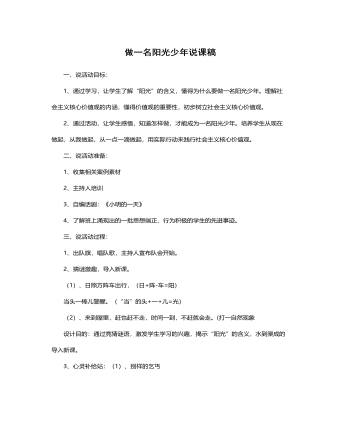
做一名阳光少年说课稿
1、紧密联系学生的生活实际,所选材料、所有活动均本着为主题服务的原则。2、形式多样化。通过心灵补给站、我来当编剧、心动不如行动等丰富多彩的活动,激发学生的热情,充分发挥他们的主体性。3、用生活中的真人真事激励他们,震撼他们的心灵,对学生进行教育,让他们得到感悟。五、说评价方式:要真正发挥主题队会的教育作用,千万不能把主题队会开成“检讨会”、“批评会”。兴趣是最好的老师,在课堂上,学生有了兴趣,才会有学习的动机,所以,在教学过程中,我努力把学生当作一个平等的朋友来对待,对于学生的回答进行评价时,本着“多表扬少批评,多鼓励少指责”的原则,尽量不用指令性、批评性的语言,最大限度的挖掘学生的优点,进行激烈性评价。

追思先烈魂,弘扬爱国情说课稿
环节四深入实践——弘扬爱国情爱国不是一句口号,要将爱国情怀落实到行动中去,队员们在各队队长的组织下,商讨出了落实方案。1、第一小队和第二小队组成了先烈故事演讲团,利用班会十分钟的时间,在三四年级宣讲先烈故事。2、第三小队和第四小队组成了创编小能手,编唱了爱国童谣、爱国拍手歌,告诉大家,爱国无处不在,爱国要从小事做起。3、第五小队和第六小队编写的爱国倡议书,提倡大家让爱国从口号落实到行动。4、全体队员共同宣誓:时刻准备着,为共产主义事业而奋斗,将活动推向了高潮。环节五大队辅导员总结“风雨沧桑,多遭铁蹄践踏,未有沉沦终奋起;荡涤污浊,重聚华夏精魂,披荆斩棘勇向前。”让我们牢记自己是中国人,怀一颗中国心,明确方向,努力奋斗,早日实现自己的梦想。
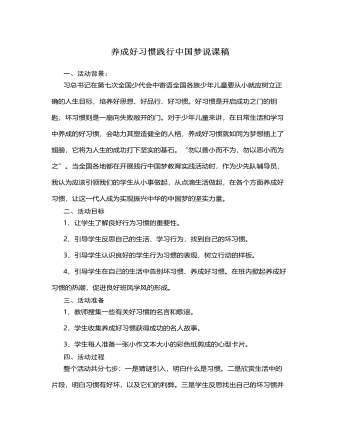
养成好习惯践行中国梦说课稿
第七步:全班学生一起倡读承诺书:(课件出示)我们都是小学生,培养习惯最要紧;上课应当专心听,积极开动小脑筋;作业认真仔细做,按时完成交得勤;有了错误要订正,知识才能学得清;人生要有好习惯,我们牢牢记心上。最后请学生把自己要养成的好习惯写在心意卡上,写好后粘贴在教室后面的园地里,互相督促,使得此次活动教育延续课后,直至影响一生.5、活动效果及反思此次活动开展后,学生们增强了对自身的认识,很多学生下决心改掉自身的坏习惯,并逐步采取了实际行动,从身边的小事做起,而且在学生中间还兴起了互相帮助、互相指正、争相进步的热潮。通过此次活动我也切实的体会到养成教育要开展就要落到实处,从实际出发,让学生亲自去感受,去体会,并且要持之以恒的做下去。同时作为老师更应该有一颗敏感热情的心,随时发现学生身上的闪光点与不足,多指正、多指点、多鼓励、多表扬,做到时时处处皆教育,这样才能赢得孩子,做好教育。
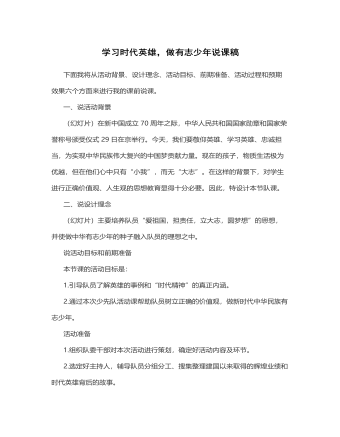
学习时代英雄,做有志少年说课稿
一、说活动背景(幻灯片)在新中国成立70周年之际,中华人民共和国国家勋章和国家荣誉称号颁受仪式29日在京举行。今天,我们要敬仰英雄、学习英雄、忠诚担当,为实现中华民族伟大复兴的中国梦贡献力量。现在的孩子,物质生活极为优越,但在他们心中只有“小我”,而无“大志”。在这样的背景下,对学生进行正确价值观、人生观的思想教育显得十分必要。因此,特设计本节队课。二、说设计理念(幻灯片)主要培养队员“爱祖国,担责任,立大志,圆梦想”的思想,并使做中华有志少年的种子融入队员的理想之中。说活动目标和前期准备本节课的活动目标是:1.引导队员了解英雄的事例和“时代精神”的真正内涵。2.通过本次少先队活动课帮助队员树立正确的价值观,做新时代中华民族有志少年。
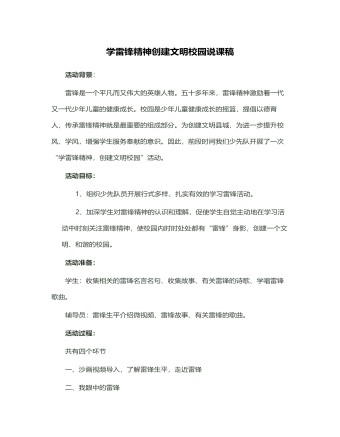
学雷锋精神,创建文明校园说课稿
雷锋精神是什么?这一环节是让学生用简单的词语或句子概括。通过这一活动,让学生概括出雷锋精神的内涵:像无私奉献、乐于助人、为人民服务、勤俭节约、尊老爱幼、勤奋好学、干一行爱一行、言行一致等等都是雷锋精神的体现。我们少年儿童是中国的未来和希望,雷锋精神的发扬和光大,创建文明校园的任务就落在他们的肩上,所以在这里我还设计了为发扬雷锋精神,创建文明校园“我该怎么做”这样的问题,目的就是让他们一起行动起来,学雷锋做好事,并制作了“荣誉”旗,奖励身边的好人好事。活动延伸:这里我设计了一个角色游戏活动——我要义卖献爱心,这个游戏学生们表现得非常积极,他们收集了自己不要的小文具或小玩具,将他们拿到集市上去卖,卖东西获得的钱,捐给王奶奶的孙女,因为王奶奶的孙女生病了,无钱治病。我觉得这个游戏使学生们懂得,一个人只要有爱心,只要愿意去帮助别人,无论什么方式都行,而且在游戏活动中孩子们体会到了帮助别人是一件多么多么快乐的事呀。
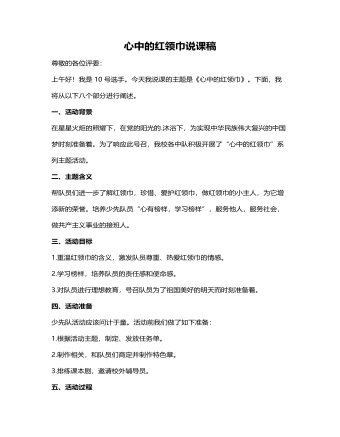
心中的红领巾说课稿
1.学习“最美红领巾”。图文结合,学习“美德少年”刘华婷、刘颖等人的先进事迹。2.记录“平凡红领巾”。展示队员们活动前精心准备的“随手拍”,发现普通队员在日常生活中的闪光点。3.填写“我为红领巾添光彩”心愿卡,对学生进行理想教育。4.齐唱《红领巾之歌》,点燃信念火种。5.辅导员对此次活动进行总结,并颁发特色章。(出示三个特色章图标)六、活动延伸红领巾精神需要代代相传,珍爱红领巾的意识需要时时提醒,本次活动后,我们会开展“小小新四军”、“鲜艳的红领巾”等后续活动,帮助队员们将红领巾精神永远铭记在心。七、引导要点四年级队员具备一定的活动能力和经验,通过课本剧的亲身体验、心愿卡的真情表达等多种方式的运用,引导队员热爱红领巾,以红领巾精神指引自己健康成长。八、活动评价本次活动,队员们受到了良好的教育。但是四年级队员自我约束能力不够强,缺乏持久性,萌生的意识和激情往往只停留在活动时,不能在活动后内化为自觉行为,这些问题有待探究。
今日更新Word
-

精选高中生期末评语
1、该生学习态度端正 ,能够积极配合老师 ,善于调动课堂气氛。 能够积极完成老师布置的任务。学习劲头足,听课又专注 ,做事更认 真 ,你是同学们学习的榜样。但是,成绩只代表昨天,并不能说明你 明天就一定也很优秀。所以,每个人都应该把成绩当作自己腾飞的起 点。2、 你不爱说话 ,但勤奋好学,诚实可爱;你做事踏实、认真、为 人忠厚 ,是一个品行端正、有上进心、有良好的道德修养的好学生。在学习上,积极、主动,能按时完成老师布置的作业,经过努力 ,各 科成绩都有明显进步,你有较强的思维能力和学习领悟力,学习也有 计划性,但在老师看来,你的潜力还没有完全发挥出来,学习上还要有持久的恒心和顽强的毅力。
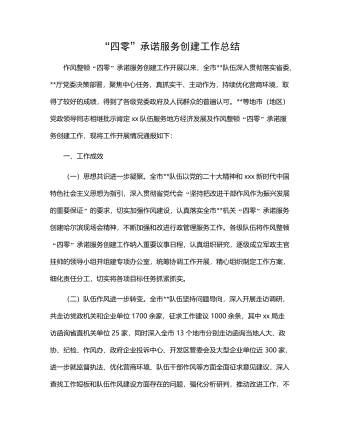
“四零”承诺服务创建工作总结
(二)坚持问题导向,持续改进工作。要继续在提高工作效率和服务质量上下功夫,积极学习借鉴其他部门及xx关于“四零”承诺服务创建工作的先进经验,同时主动查找并着力解决困扰企业和群众办事创业的难点问题。要进一步探索创新,继续优化工作流程,精简审批程序,缩短办事路径,压缩办理时限,深化政务公开,努力为企业当好“保姆”,为群众提供便利,不断适应新时代人民群众对政务服务的新需求。(三)深化内外宣传,树立良好形象。要深入挖掘并及时总结作风整顿“四零”承诺服务创建工作中形成的典型经验做法,进一步强化内部宣传与工作交流,推动全市创建工作质效整体提升。要面向社会和公众庄严承诺并积极践诺,主动接受监督,同时要依托电台、电视台、报纸及微信、微博等各类媒体大力宣传xx队伍作风整顿“四零”承诺服务创建工作成果,不断扩大社会知情面和群众知晓率。
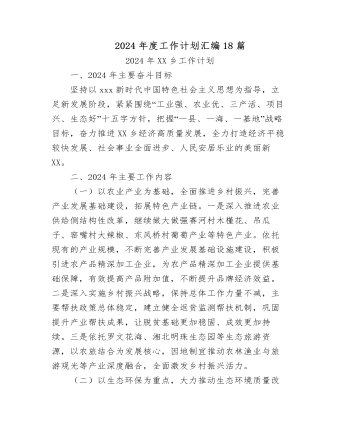
2024年度工作计划汇编(18篇)
1.市政基础设施项目5项,总建设里程2.13km,投资概算2.28亿元。其中,烔炀大道(涉铁)工程施工单位已进场,项目部基本建成,正在办理临时用地、用电及用水等相关工作;中铁佰和佰乐(巢湖)二期10KV外线工程已签订施工合同;黄麓镇健康路、纬四路新建工程均已完成清单初稿编制,亟需黄麓镇完成图审工作和健康路新建工程的前期证件办理;公安学院配套道路项目在黄麓镇完成围墙建设后即可进场施工。2.公益性建设项目6项,总建筑面积15.62万㎡,投资概算10.41亿元。其中,居巢区职业教育中心新建工程、巢湖市世纪新都小学扩建工程已完成施工、监理招标挂网,2月上旬完成全部招标工作;合肥职业技术学院大维修三期已完成招标工作,近期签订施工合同后组织进场施工;半汤疗养院净化和医用气体工程已完成招标工作;半汤疗养院智能化工程因投诉暂时中止;巢湖市中医院(中西医结合医院)新建工程正在按照既定计划推进,预计4月中下旬挂网招标。

驻村工作队2024年第一季度工作总结汇编(4篇)
三是做大做强海产品自主品牌。工作队于xx年指导成立的冬松村海产品合作社,通过与消费帮扶平台合作,在工作队各派出单位、社会团体、个人支持下,已获得逾xx万元销售额。2022年底工作队推动合作社海产品加工点扩建的工作方案已获批,待资金下拨后将正式启动扩建工作。四是积极助企纾困,带动群众增收致富。工作队利用去年建立的xx镇产业发展工作群,收集本地企业在产品销售、技术、人力、资金、运营、用地等方面的需求,并加大xx支持乡村振兴力度,xx助理赴各村委开展多场xx政策支持乡村振兴宣讲活动,本季度有x万元助农贷款获批,xx万贷款正在审批中。在壮大既有产业的同时,完善联农带农机制,一方面鼓励企业雇用本地农户就业,另一方面计划与本地农户签订长期收购合同,让农民种得放心、种得安心,带动当地群众共同致富。

主题教育总结常用提纲大全
第一,主题教育是一次思想作风的深刻洗礼,初心传统进一步得到回归。第二,主题教育是一次沉疴积弊的集中清扫,突出问题进一步得到整治。第三,主题教育是一次强化为民服务的生动实践,赤子之情进一步得到提振。第四,主题教育是一次激发创业担当的有利契机,发展层次进一步得到提升。2.第一,必须提领思想、武装思想。第二,必须聚焦问题、由表及里。第三,必须领导带头、以上率下。第四,必须务实求实、认真较真。3.一是抬高政治站位,坚持大事大抓。二是坚持思想领先,狠抓学习教育。三是突出问题导向,深入整改纠治。四是坚持领导带头,发挥表率作用。4.一是立足“早”字抓筹划。二是着眼“活”字抓学习。三是围绕“统”字抓协调。5.一是形势所需。二是任务所系。三是职责所在。四是制度所定。6.一要提升认识。二要积极作为。三要密切协作。
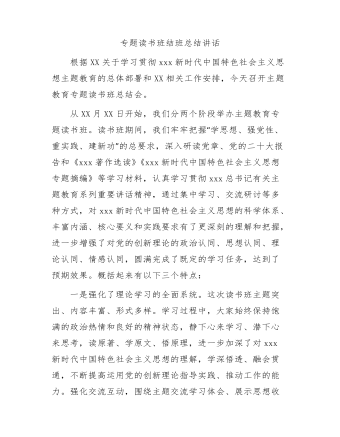
主题教育专题读书班结班总结讲话
第二,要把调查研究贯穿始终,实干担当促进发展。开展好“察实情、出实招”“破难题、促发展”“办实事、解民忧”专项行动,以强化理论学习指导发展实践,以深化调查研究推动解决发展难题。领导班子成员要每人牵头XX个课题开展调查研究,XX月底前召开调研成果交流会,集思广益研究对策措施。各部门、各单位要制定调研计划,通过座谈访谈、问卷调查、统计分析等方式开展调查研究,解决工作实际问题,帮助基层单位和客户解决实际困难。第三,要把检视问题贯穿始终,廉洁奉公树立新风。认真落实公司主题教育整改整治工作方案要求,坚持边学习、边对照、边检视、边整改,对标对表xxx新时代中国特色社会主义思想,深入查摆不足,系统梳理调查研究发现的问题、推动发展遇到的问题、群众反映强烈的问题,结合巡视巡察、审计和内外部监督检查发现的问题,形成问题清单。


















